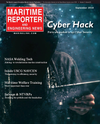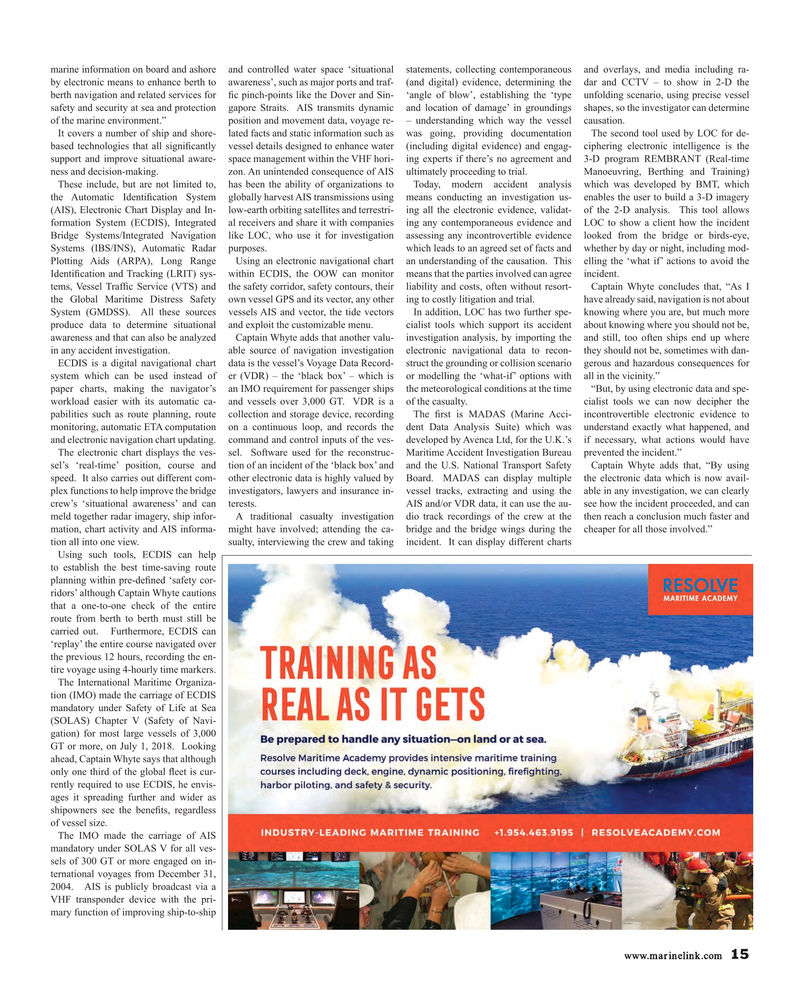
Page 15: of Maritime Reporter Magazine (September 2018)
Maritime Port & Ship Security
Read this page in Pdf, Flash or Html5 edition of September 2018 Maritime Reporter Magazine
marine information on board and ashore and controlled water space ‘situational statements, collecting contemporaneous and overlays, and media including ra- by electronic means to enhance berth to awareness’, such as major ports and traf- (and digital) evidence, determining the dar and CCTV – to show in 2-D the berth navigation and related services for ? c pinch-points like the Dover and Sin- ‘angle of blow’, establishing the ‘type unfolding scenario, using precise vessel safety and security at sea and protection gapore Straits. AIS transmits dynamic and location of damage’ in groundings shapes, so the investigator can determine of the marine environment.” position and movement data, voyage re- – understanding which way the vessel causation.
It covers a number of ship and shore- lated facts and static information such as was going, providing documentation The second tool used by LOC for de- based technologies that all signi? cantly vessel details designed to enhance water (including digital evidence) and engag- ciphering electronic intelligence is the support and improve situational aware- space management within the VHF hori- ing experts if there’s no agreement and 3-D program REMBRANT (Real-time ness and decision-making. zon. An unintended consequence of AIS ultimately proceeding to trial. Manoeuvring, Berthing and Training)
These include, but are not limited to, has been the ability of organizations to Today, modern accident analysis which was developed by BMT, which the Automatic Identi? cation System globally harvest AIS transmissions using means conducting an investigation us- enables the user to build a 3-D imagery (AIS), Electronic Chart Display and In- low-earth orbiting satellites and terrestri- ing all the electronic evidence, validat- of the 2-D analysis. This tool allows formation System (ECDIS), Integrated al receivers and share it with companies ing any contemporaneous evidence and LOC to show a client how the incident
Bridge Systems/Integrated Navigation like LOC, who use it for investigation assessing any incontrovertible evidence looked from the bridge or birds-eye,
Systems (IBS/INS), Automatic Radar purposes. which leads to an agreed set of facts and whether by day or night, including mod-
Plotting Aids (ARPA), Long Range Using an electronic navigational chart an understanding of the causation. This elling the ‘what if’ actions to avoid the
Identi? cation and Tracking (LRIT) sys- within ECDIS, the OOW can monitor means that the parties involved can agree incident.
tems, Vessel Traf? c Service (VTS) and the safety corridor, safety contours, their liability and costs, often without resort- Captain Whyte concludes that, “As I the Global Maritime Distress Safety own vessel GPS and its vector, any other ing to costly litigation and trial. have already said, navigation is not about
System (GMDSS). All these sources vessels AIS and vector, the tide vectors In addition, LOC has two further spe- knowing where you are, but much more produce data to determine situational and exploit the customizable menu. cialist tools which support its accident about knowing where you should not be, awareness and that can also be analyzed Captain Whyte adds that another valu- investigation analysis, by importing the and still, too often ships end up where in any accident investigation. able source of navigation investigation electronic navigational data to recon- they should not be, sometimes with dan-
ECDIS is a digital navigational chart data is the vessel’s Voyage Data Record- struct the grounding or collision scenario gerous and hazardous consequences for system which can be used instead of er (VDR) – the ‘black box’ – which is or modelling the ‘what-if’ options with all in the vicinity.” paper charts, making the navigator’s an IMO requirement for passenger ships the meteorological conditions at the time “But, by using electronic data and spe- workload easier with its automatic ca- and vessels over 3,000 GT. VDR is a of the casualty. cialist tools we can now decipher the pabilities such as route planning, route collection and storage device, recording The ? rst is MADAS (Marine Acci- incontrovertible electronic evidence to monitoring, automatic ETA computation on a continuous loop, and records the dent Data Analysis Suite) which was understand exactly what happened, and and electronic navigation chart updating. command and control inputs of the ves- developed by Avenca Ltd, for the U.K.’s if necessary, what actions would have
The electronic chart displays the ves- sel. Software used for the reconstruc- Maritime Accident Investigation Bureau prevented the incident.” sel’s ‘real-time’ position, course and tion of an incident of the ‘black box’ and and the U.S. National Transport Safety Captain Whyte adds that, “By using speed. It also carries out different com- other electronic data is highly valued by Board. MADAS can display multiple the electronic data which is now avail- plex functions to help improve the bridge investigators, lawyers and insurance in- vessel tracks, extracting and using the able in any investigation, we can clearly crew’s ‘situational awareness’ and can terests. AIS and/or VDR data, it can use the au- see how the incident proceeded, and can meld together radar imagery, ship infor- A traditional casualty investigation dio track recordings of the crew at the then reach a conclusion much faster and mation, chart activity and AIS informa- might have involved; attending the ca- bridge and the bridge wings during the cheaper for all those involved.” tion all into one view. sualty, interviewing the crew and taking incident. It can display different charts
Using such tools, ECDIS can help to establish the best time-saving route planning within pre-de? ned ‘safety cor- ridors’ although Captain Whyte cautions that a one-to-one check of the entire route from berth to berth must still be carried out. Furthermore, ECDIS can ‘replay’ the entire course navigated over the previous 12 hours, recording the en- tire voyage using 4-hourly time markers.
The International Maritime Organiza- tion (IMO) made the carriage of ECDIS mandatory under Safety of Life at Sea (SOLAS) Chapter V (Safety of Navi- gation) for most large vessels of 3,000
GT or more, on July 1, 2018. Looking ahead, Captain Whyte says that although only one third of the global ? eet is cur- rently required to use ECDIS, he envis- ages it spreading further and wider as shipowners see the bene? ts, regardless of vessel size.
The IMO made the carriage of AIS mandatory under SOLAS V for all ves- sels of 300 GT or more engaged on in- ternational voyages from December 31, 2004. AIS is publicly broadcast via a
VHF transponder device with the pri- mary function of improving ship-to-ship www.marinelink.com 15
MR #9 (10-17).indd 15 MR #9 (10-17).indd 15 9/5/2018 1:30:35 PM9/5/2018 1:30:35 PM

 14
14

 16
16
